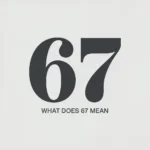Language evolves, culture evolves, and the way people describe identity evolves with it. That’s why words you might’ve seen only in textbooks or old movies are getting a fresh, modern meaning online—especially among Gen-Z. One of the most talked-about and redefined words today is the term queer.
From TikTok conversations to Instagram captions to Pride posts, this term shows up everywhere. But what does it actually mean? Why is it used so confidently today when it once carried negativity? And how do you use it respectfully in real-life and digital conversations?
Let’s break it all down in the clearest, simplest, and trendiest way possible.
🔍 Quick Answer (Super Simple)
Queer is an inclusive umbrella term people use to describe identities that aren’t strictly heterosexual or cisgender.
It’s flexible, broad, and allows people to express their individuality without being boxed into one specific label.
Today, the term often celebrates authenticity, diversity, and the freedom to exist outside traditional expectations.
🌈 The Modern Meaning: Why the Word Has Evolved
The term now highlights fluidity, openness, and personal identity. Instead of pointing to one exact definition, it offers space for people to describe their experiences with:
- Attraction
- Gender identity
- Expression
- Cultural alignment
- Community connection
For many people, the term feels comfortable because it’s not hyper-specific. It doesn’t force someone to fit into one box when they feel somewhere in between—or even outside all of them.
🧠 A Quick History: How the Meaning Shifted Over Time
Understanding the background helps you understand its powerful reclaiming.
⚫ Originally negative
In the early 1900s, the term was used in a derogatory way to target anyone who didn’t follow traditional norms around gender or sexuality.
⚫ Reclaimed by LGBTQ+ communities
By the 1980s–1990s, activists, artists, and academics began reclaiming the term as a symbol of unity, strength, and resistance.
⚫ Now widely used in Gen-Z and internet culture
Today, it’s embraced across social media, Pride events, online bios, and everyday life as an empowering identity marker.
🌟 Why People Choose This Term Today
Not everyone feels represented by one narrow label. Some people prefer this term because:
1. It feels flexible
Identity isn’t always black and white. This term allows room to explore.
2. It avoids over-specific labels
Some people don’t want to say, “I am exactly this.” They want a word that leaves breathing room.
3. It offers community
It signals belonging to a broader, supportive, inclusive group.
4. It’s culturally modern
It aligns with Gen-Z’s preference for fluidity, authenticity, and dropping outdated expectations.
5. It stands for empowerment
Using it can feel like reclaiming something that once harmed people.
💬 How People Use the Word in Real Life (With Examples)
1. Describing Identity
“I identify as queer because it fits how I feel about my gender and attraction.”
2. In casual intros
“Here’s a little queer fashion inspo for Pride Month!”
3. In academic or cultural contexts
“This museum is hosting a queer art exhibit exploring identity.”
4. In conversations about community
“There’s a queer meetup downtown this weekend.”
5. In digital bios
- “Queer 🏳️🌈 | Artist 🎨 | Mental Health Advocate”
- “Queer • They/Them • Coffee Enthusiast”
❗ Important Note: Context Matters
Even though the term is widely reclaimed and used positively, tone still matters.
When using it:
- Make sure you’re using it respectfully.
- Never use it as an insult or stereotype.
- Follow the lead of the person you’re describing—if they use it for themselves, it’s safe to follow.
- Avoid assuming someone’s identity.
🧩 Identity Terms Related to This Concept (Useful LSI Keywords)
Here are related concepts people often search for or use alongside:
- LGBTQ+
- Non-binary
- Gender-fluid
- Sexual orientation
- Gender spectrum
- Identity labels
- Pride terminology
- Inclusive language
- Self-expression
- Gender identity
- Sexuality spectrum
- Community-focused identities
These help search engines understand context while keeping your content meaningful and natural.
🗣️ When Should You Use the Term?
Use it when:
✔ Someone describes themselves this way
✔ You’re talking about the community as a whole
✔ You’re referring to culture, events, media, or art
✔ You’re writing affirming content
✔ You want to be inclusive without forcing specifics
Avoid it when:
✘ Making assumptions about someone
✘ Using it as a label for another person without permission
✘ Referring to past prejudiced contexts
✘ Using it in a sarcastic or mocking tone
🌐 How the Term Shows Up Online (Social Media Examples)
- “Celebrating queer joy today 💛”
- “Outfits inspired by queer creators!”
TikTok
- “POV: You’re scrolling through queer book recommendations.”
- “Aesthetic ideas for your queer-themed photoshoot.”
Twitter/X
- “So many queer stories deserve the spotlight.”
- “Queer-friendly decor ideas 🌈”
The word’s presence across platforms shows its shift from taboo to celebrated.
🎨 Pop Culture, Media & Art Influence
Movies, music, fashion, and digital creators have helped make the term mainstream. Think:
- Inclusive TV shows
- Representation in films
- Music artists openly discussing identity
- Influencers sharing their journey
- Pride campaigns from global brands
The more representation increases, the more people feel safe and confident using the term.
🌱 Why Language Like This Matters
Using inclusive, modern terms helps:
- Normalize diverse identities
- Reduce stigma
- Promote healthy conversations
- Make spaces more welcoming
- Support mental well-being
Language has power. When people feel seen in words, they feel seen in the world.
🎭 Myths & Misconceptions (Debunked)
❌ “It only means one thing.”
No. It’s intentionally broad.
❌ “Only certain people are allowed to use it.”
Anyone describing their own experience can choose it.
❌ “It’s outdated.”
Modern culture has revived it in a positive way.
❌ “It’s a negative word.”
It was, historically. But its reclaimed meaning is empowering.
🏳️🌈 Identity Is Personal — And This Word Honors That
The beauty of this term is that it accommodates a range of experiences. Some people use it temporarily. Some use it permanently. Some use it alongside other labels. Others use it as their primary identity term.
There’s no “right” way. Just the way that feels most authentic to you.
🌈 Respectful Ways to Ask Someone About Their Identity
If needed, keep it simple and polite:
- “How do you identify, if you’re comfortable sharing?”
- “What label feels right for you?”
- “How should I refer to your identity?”
Always let the other person lead.
Identity is private, personal, and fluid.
🧭 Why Gen-Z Relates So Much to This Term
Gen-Z tends to value:
- Authenticity
- Fluidity
- Breaking stereotypes
- Mental health awareness
- Community belonging
This term matches that mindset perfectly. It’s non-restrictive, modern, and expressive.
📚 Using It in Writing, Captions & Bios
Here are examples you can use for posts, blogs, or profiles:
- “Celebrating queer culture through fashion.”
- “A space for queer creators and allies.”
- “Exploring queer identity in art and literature.”
- “Proudly sharing queer stories that inspire.”
Short, aesthetic, and respectful.
🔥 Wrap-Up: Why This Term Matters Today
The term represents transformation. What once was used to shame people is now used to empower them. It stands for inclusion, identity, and the right to define yourself on your own terms.
It’s flexible. It’s positive. It’s expressive.
And it gives people the freedom to describe who they are without limitations.
At the end of the day, identity isn’t about fitting into boxes—it’s about feeling understood, respected, and seen. And this term helps many people feel exactly that.
🏁 Conclusion
Identity is deeply personal, and language should help people express their truth—not hide it. This term does exactly that.
Reclaimed, redefined, and reshaped by modern culture, it now represents pride, community, and the beauty of individuality.
Using it with respect means celebrating diversity, supporting authenticity, and helping create spaces where everyone feels free to exist exactly as they are.











